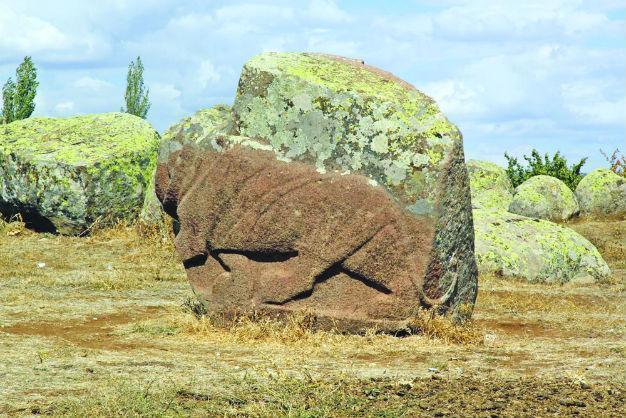The mystery of Hittite lions
YOZGAT – Doğan News Agency

DHA photo
Archaeologists have been working to solve the mystery of five-ton lion sculptures recently found in a field in Sorgun, a town located in the Central Anatolian province of Yozgat.Two researchers employed by the Culture and Tourism Ministry have made preliminary searches in Sorgun’s Yeniyer neighborhood, where they say a field served as a sculpture atelier in the Hittite era. Now it is expected that the field will turn into an open air park museum, shedding light on a period of Turkey’s ancient history.
Yeniyer Mayor Osman Yilmaz stated, “It is not exactly known why these lion sculptures were created. It is estimated that they were made between 1,400 and 1,200 B.C. during the era when the Hittites ruled Anatolia. … The top part of their head is a bit higher than their neck. It is thought that these sculptures were dedicated to a holy water source.”
Large rocks in a stone pit, the biggest of which is in two-meter diameter, have also been found in the field, further complicating the mystery.
Commenting on the sculpture’s possible purpose, Yılmaz said, “Research done around Karakız [a Yeniyer neighborhood] show that the region was a Hittite settlement when these sculptures were created. On the other hand, due to the gigantic size of the lions, it was not much possible to make them in another place and move them here.”
Lions seek promotion
But the sculptures and the neighborhoods around the field, though highly interesting to researchers, are desperately seeking attention from tourists.
Yılmaz said the Yeniyer’s neighborhoods of Karakız, Kazankaya, Armutlu and Hapis Boğazı were home to important archaeological artifacts, and added, “The first artifacts were found in 1982 by the Yozgat Museum Directorate. In 1987, the Hapis Boğazı ruins were put under protection. The museum directorate registered this field in 2009 as the Karakız Sculpture Atelier.”
Yılmaz said due to lack of sufficient protection, treasure hunters had already damaged the ancient artifacts.
“People who are searching for treasure in the region damaged these artifacts; they damaged the stones. This is why we are waiting for administrators, parliamentarians and ministers in Yozgat to accelerate works in this region and open it to tourism. Otherwise, such a significant history will disappear.”
Yılmaz said experts had organized the first Hapis Boğazı Hittite Sculpture Atelier Festival last year and they would organize the second edition this year.
“We organized an event last year in Karakız and Hapis Boğazı to contribute to the promotion of the Hittite Sculpture Atelier. We set to organize the second festival this year on July 9 and 10. We believe such events will promote the region,” he said.
















